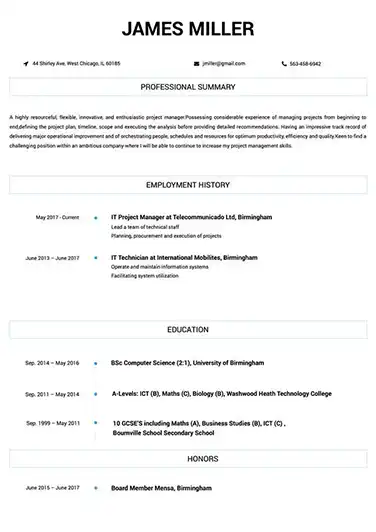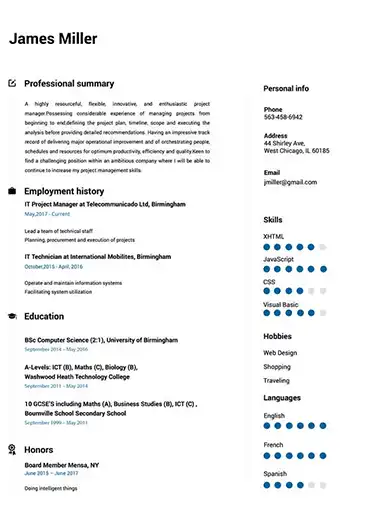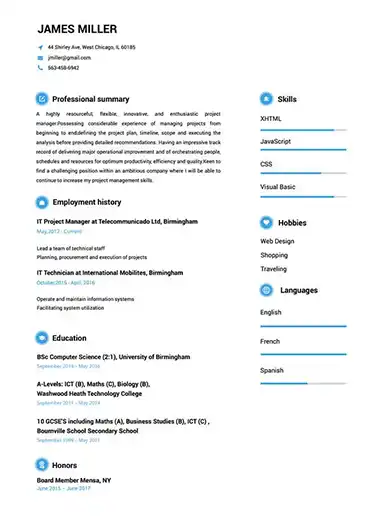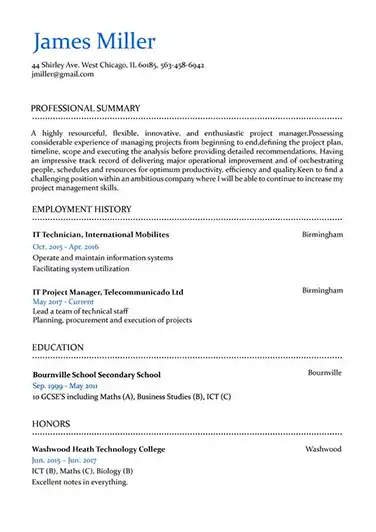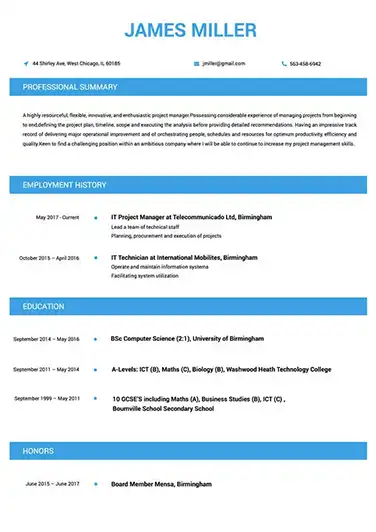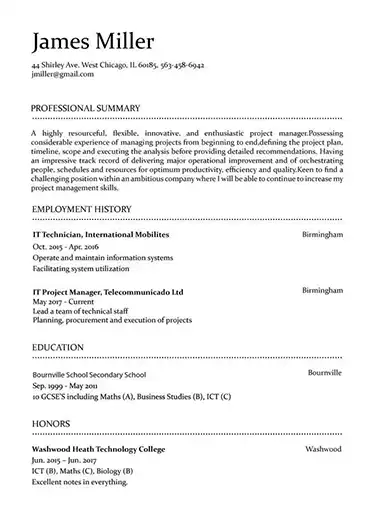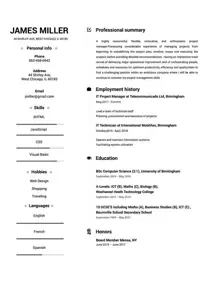 Use This Template
Use This Template
Build your resume in 15 minutes
Create an awesome resume that meets the expectations of potential employers with our selection of professional, field-tested resume templates.
scrum master: Resume Samples & Writing Guide
millerrob@inbox.com
605-551-6336
Professional Summary
Employment history
- Act as a buffer between the team and any distracting influences
- Proactively identify risks and issues that may affect the team and escalate to stakeholders
- Foster collaboration, trust and knowledge sharing within the team
- Foster collaboration, trust and knowledge sharing within the team
- Assist the Product Owner in managing product backlogs and sprint backlogs
- Provide coaching and guidance to the team on Agile and Scrum practices
- Ensure that the team is adhering to Scrum principles and practices
- Remove any impediments or blockers the team encounters
- Help to ensure that the team is focused on delivering value to the customer
Education
Skills
Do you already have a resume? Use our PDF converter and edit your resume.
oscarwhite64@yandex.com
872-560-1608
Employment history
- Support the Product Owner in grooming and maintaining the product backlog
- Monitor progress, track and report metrics, and provide visibility to stakeholders
- Ensure that the team is adhering to Scrum principles and practices
- Ensure that the team is adhering to Scrum principles and practices
- Ensure that the team is following established processes and procedures
- Foster collaboration, trust and knowledge sharing within the team
- Ensure that the team is following established processes and procedures
- Act as a buffer between the team and any distracting influences
- Help to ensure that the team is focused on delivering value to the customer
Education
Skills
virginia_walker@yahoo.com
727-404-7320
Employment history
- Foster collaboration, trust and knowledge sharing within the team
- Help to ensure that the team is meeting its commitments
- Provide coaching and guidance to the team on Agile and Scrum practices
- Ensure that the team is following established processes and procedures
- Remove any impediments or blockers the team encounters
- Ensure that the team is adhering to Scrum principles and practices
- Ensure that the team is following established processes and procedures
- Support the Product Owner in grooming and maintaining the product backlog
- Ensure that the team is adhering to Scrum principles and practices
Education
Skills
bernieingram61@yahoo.com
890-079-5964
Professional Summary
Employment history
- Facilitate Scrum ceremonies (e.g. sprint planning, daily stand-ups, sprint reviews, retrospectives)
- Help to ensure that the team is focused on delivering value to the customer
- Help to ensure that the team is meeting its commitments
- Act as a buffer between the team and any distracting influences
- Help to ensure that the team is focused on delivering value to the customer
- Foster collaboration, trust and knowledge sharing within the team
- Help to ensure that the team is meeting its commitments
- Ensure that the team is following established processes and procedures
- Monitor progress, track and report metrics, and provide visibility to stakeholders
Education
Skills
robertsvictor0@aol.com
736-431-6467
Employment history
- Ensure that the team is following established processes and procedures
- Ensure that the team is adhering to Scrum principles and practices
- Facilitate Scrum ceremonies (e.g. sprint planning, daily stand-ups, sprint reviews, retrospectives)
- Support the Product Owner in grooming and maintaining the product backlog
- Ensure that the team is adhering to Scrum principles and practices
- Help to ensure that the team is meeting its commitments
- Help the team to self-organize and self-manage
- Foster collaboration, trust and knowledge sharing within the team
- Proactively identify risks and issues that may affect the team and escalate to stakeholders
Education
Skills
Not in love with this template? Browse our full library of resume templates
In theory, putting together an ideal Scrum master resume is simple. You just need to demonstrate a mastery of Scrum principles and show experience putting them in practice. However, as a Scrum master, you’re well familiar with all the problems that arise when theory meets practice and crafting your resume is no different.
You need your resume to show that you can effectively implement Scrim principles and use them to get great results for the product owner. This guide will take you through all of the tricks and principles you need to follow to do just that.
What this guide will teach you
- How to take inspiration from Scrum master resume examples
- What makes a Scrum master resume stand out
- How to write for ATS and recruiters alike
- The formatting rules you need to follow
- How to include education, training, and certifications for maximum impact
- The best skills to include and how to list them
- How to highlight your achievements
- Why starting with an objective or summary is ideal
- What to do if you have little or no Scrum master experience
- Why a resume builder is a critical tool for success
There’s a lot to get to, so let’s get started.
Scrum master resume examples
You might describe yourself as a kind of product manager to your grandparents but you know that being a Scrum master is really its own thing. That’s why you should start the resume creation process by taking inspiration from resumes crafted just for Scrum masters like yourself.
Before you think “I know what a resume looks like” and move on to the other sections, stop and take a look at these examples. Try listing what you like and don’t like about each, what stands out to you. Imagine yourself as a recruiter or product owner, what would you think of each of these resumes? We’re going to talk about the power of putting yourself in those shoes throughout this guide, so start here and you’ll be ready for what comes next.
[Examples]
How to write a Scrum master resume that will get you noticed
As someone applying for a Scrum master position, you’re asking for a lot of responsibility. That’s why your resume needs to inspire confidence in you and your abilities. Doing that means showing instead of telling (if that sounds strange for a written document, don’t worry it will make sense). Including examples and specifics about your approach and the results you’ve gotten will be key.
But before you begin writing, you need to understand the two primary audiences your resume needs to resonate with.
The most important thing most Scrum master applicants don’t do on their resume
Three simple letters lead to as many as 75% of otherwise qualified resumes never seeing the light of day (or the screen of a recruiter): ATS. Applicant Tracking Systems are algorithms which use artificial intelligence to scan large numbers of resumes and sort them into “review further” and “discard” piles. These systems are increasingly popular because of the time they save for HR teams, however as the 75% figure cited above indicates, they have their problems.
Although there are dozens of ATS companies out there each with a slightly different system, they all share some limitations that you as a job applicant need to be familiar with. The good news is that by following these tips you can be confident your resume won’t be part of that 75%, giving you a substantial advantage when applying at companies which use ATS (which is most of them)
- Make sure the resume you submit is the right file type. This one is easy. ATS are generally designed to read .doc, .docx, and .pdf files. So by submitting your resume in one of these 3 file types, yours won’t be rejected out of hand like your friend who thought it would be cool to send their resume as a movie or an image file.
- Use a resume builder to ensure the data in that file is easily readable by ATS. Although ATS are set up to read the file types we mentioned, they can still easily get confused by the way that data is structured within the file. Images, charts, columns, etc. can all potentially cause problems. The best way to ensure this doesn’t happen is to create your resume using a builder specifically designed to create ATS-friendly files.
- Think like an ATS algorithm and use keywords cleverly. If you’re familiar with how keywords are used in SEO, then this should make sense to you. ATS algorithms scan your resume trying to understand your skills and experience similar to the way Google’s algorithms scan a website to understand its content. What you need to do is make this process easy. That requires first understanding what the ATS is looking for by studying the job ad. Then, you need to take the requirements in the job ad and get those keywords into your resume as closely as possible to how they’re originally written (and without lying, because lying on your resume is never a good idea).
By following these 3 steps, your resume will be more prepared for ATS than the vast majority of other Scrum masters out there, giving you a substantial heads up.
How to get in the head of a recruiter or product owner
Whether or not the place you’re applying to uses ATS, your resume will still need to impress a human. For larger companies, this will be a recruiter, hiring manager, or someone else in HR. For a smaller company or freelance gig, this will probably be the product owner themselves. Either way, your resume needs to be laser-focused on them and their needs.
Look back at the job ad and ask yourself what this company or team needs from a Scrum master. You’re being hired to do more than simply fulfill a role, you’ll be helping them achieve larger aims. Understanding those aims and representing them in your resume will help you stand out from the competition.
For example, if a company is looking to hire you because they want to try Scrum, you should demonstrate your knowledge of the system so you can help them through the implementation. On the other hand, if the company needs a Scrum master because their product development process is a mess, you can emphasize examples when you’ve stepped in and improved processes.
The bigger idea is that your resume should communicate that you will solve their problem(s). If you can convince a recruiter or product owner of that, they’ll be falling over themselves to hire you.
How to format a Scrum master resume
Formatting is really about information hierarchy. The way you structure the sections on your resume tells the person reading it what’s important. That’s why resume formatting is so critical, by controlling what information gets across in what order, you can make the content of your resume more effective.
For example, a recruiter might notice a gap in your work history and wonder what happened. That uncertainty will impact how they read the rest of the information. But, if you get ahead of them and explain the gap in a resume summary (more on those later), then you’ll avoid that problem.
The bigger principle is to put the most important information towards the top. This means you’ll want to put your work experience in reverse chronological order, meaning your most recent experience is listed first. But it also gets to the question of what is important and the ever popular “how long should my resume be?” The best rule of thumb in this case is to only include information or a section if you're confident it’s improving your resume. Nobody wants to hire a Scrum master who seems more focused on overwhelming the reader with pages of unnecessary information rather than providing a lean and focused resume.
Which sections should you include in your resume?
Using the principles we just mentioned to guide you, choose from these sections with an eye on including only the ones which best show you off as a Scrum master.
- Resume objective or summary
- Work experience
- Certifications
- Achievements
- Projects
- Education
- Hard skills
- Soft Skills
How to list your education, additional training, and certifications
Education is a tricky question for a Scrum master resume. You’re not going to have a BA in Scrum, so when should you include it and what should you mention? Put simply, if your education isn’t relevant then don’t include it. The space taken up by listing an irrelevant degree would be better used listing more important information.
Where you will want to spend more time and focus is on additional training and certifications related to your Scrum work.
But if you do feel the need to include your education, here are some examples to illustrate how to do that.
BA in Linguistics
University of Wisconsin Madison
1999-2005
-Member of Linguistics Honor Society
-Varsity Rugby 2000-2002
-3.9 GPA
This example makes most of the mistakes you’ll potentially run into, so let’s explain each one. The first is really including this education at all. The chances that someone hiring you as a Scrum master care that you obtained a degree 15+ years ago are slim to none. Including this information makes you look old-fashioned. Then, this example has included many irrelevant details, wasting yet more valuable resume space (and the time of the person reading it).
BA in Management
University of Pennsylvania
2012-2016
-Wrote thesis on agile management in German auto manufacturing
This education example demonstrates what should be included. First, the degree is relevant to your work as a Scrum master. Second, the degree is much more recent. And third, the only additional detail added is one directly connected to Scum (and something which could serve as a nice topic of conversation in an interview).
Scrum master certifications to consider obtaining and including
- Professional Scrum Master (PSM) I, II, & III from Scrum.org
- Certified Scrum Master (CSM) from the Scrum Alliance
- Advanced Certified ScrumMaster (A-CSM) from the Scrum Alliance
- Certified Scrum Professional ScrumMaster (CSP-SM) from the Scrum Alliance
- Agile Certified Practitioner (ACP) from the Project Management Institute
- SAFe 4 Scrum Master
- SAFe 4 Advanced Scrum Master
How to list your skills on a Scrum master resume
As someone applying for a Scrum master role, your skills can seem less important because the core skill you’re demonstrating is the ability to function as a Scrum master. While there is some truth to that, the reality is that without listing skills you’ll have little chance of making it past ATS.
The best approach for choosing which skills to list and how to include them is to begin with the job ad. Just like we mentioned in the ATS section, you should study the description carefully and list all of the skills you believe it calls for. Now your mission is to get as many of those skills on your resume as possible.
However, while that technique will do well for ATS, a simple list of skills won’t have much of an impact on a person reading your resume. Let’s face it, simply stating that you’re good at agile planning doesn’t say much. If you want your skills to have a greater impact, you need to give concrete examples. Let’s see this in action with some examples.
Meeting facilitation
While there’s nothing inherently wrong with simply listing a skill like this, you can do better.
Meeting facilitation
-Ran monthly product development unconferences in Boston from March 2018 to June 2019
Here, simply by listing some specific experience a reader can feel far more confident in this skill. Instead of reading your skills and thinking “that sounds nice but now I need to figure out a way to determine whether they actually have that skill” a reader feels they can move on without worrying more. By making their job easier in this way, you make yourself a more enticing candidate.
The best hard skills to include
- Anything more technical related to the specific projects you’ll work on
- Burndown charts
- Agile coaching
- Scrum management
- PM tools
- Gathering requirements
- Managing backlogs
- Documentation
The best soft skills to include
- Written and verbal communication
- Organization
- Time management
- Collaboration
- Empathy
- Meeting facilitation
- Team building
- Conflict resolution
- Adaptability
- Attention to detail
How to highlight your most important achievements
Whether you’re listing examples under your skills, in your work history, or in a separate achievements section, listing your achievements the right way is one of the most effective ways to improve your resume. This is where you need to show that beyond simply muddling through and doing the bare minimum, you have an impact on the projects you get involved with.
This is particularly important for Scrum masters because your role will be very active and the quality of your work will have far ranging impacts on your team and what they produce. By showing specific impacts from your achievements, you’ll be demonstrating that you’ve got attention to detail and can get results. Now let’s look at some examples to see this in action.
Project Manager
Imperia Technologies
2014-2019, Omaha, NE
-Responsible for managing software projects
-Implemented Scrum methodology
The takeaway from this example is that this person “managed some stuff and did some Scum.” Joking aside, this description hardly inspires confidence or makes the candidate sound proactive. In 5 years at this company, if all they have to mention are these two points, there’s no reason to think they’ll be an effective Scrum master.
Project Manager and Scrum Master
Imperia Technologies
2014-2019, Omaha, NE
-Managed 40+ person software development teams creating web apps and enterprise software
-Obtained a PSM certification before implementing Scrum practices
-Reduced average project length by 18% and cost by 12% after 2 years of Scrum implementation
Reworking that example to focus more on concrete achievements makes it sound like it’s describing a completely different person. It tells a story about managing large teams, seeing the need to change work practices, studying Scrum as a solution, and then successfully implementing it with great results. The reader can clearly see how this candidate went through these steps and therefore how they work as an employee.
Why your resume should begin with an objective or summary
We mentioned earlier in this guide how critical it is to control the flow of information in your resume. The best and more flexible way to do this is with an objective or summary. In one or a few sentences, you can start by giving a summary of why you’re the best candidate for a Scrum master role.
This is also a good place to get ahead of potential questions which might arise from reading your resume like “why did you change careers?” or “why is there a gap in your work history?” When you frame the information on your resume effectively, you make all of the information in it more impactful, which is why objectives and summaries are so important.
The difference between them is largely one of length. An objective should only be about one sentence and should focus on simply explaining who you are and what you aim to achieve. A summary can be a few sentences long but should still be concise. Here you have more space to convey information which doesn’t fit easily into other resume sections.
How to write a resume objective
Your goal here is to pack as much valuable information into a few easy to understand words.
I’m an experienced and certified Scrum Master looking to use my abilities to improve development practices at your company.
There are a few mistakes to point out with this example. It’s written in the first person (your entire resume should be in the third person), it’s light on details (how experienced are you, what kind of certification do you have, how do you plan on improving practices?) and clearly shows that this resume was not written for a specific role by not mentioning the company. In other words, instead of creating a strong first impression, it leaves the person reading it with more questions than answers.
Now let’s see that same objective rewritten with those mistakes all addressed.
A-CSM Certified Scrum Master with 6 years experience looking to implement Scrum to address cost overruns and development delays at Jackson Systems.
Here you know right from the start how much experience they have, and what their main goals will be in this specific role. This creates a feeling of “I’m here to help solve your problem” instead of “hire me because I’m good at Scrum.” Ultimately, companies want to hire the former and you need to communicate that from the beginning.
How to write a resume summary
A good resume summary should follow all of the rules we just explained in the objective example.
Despite having limited direct experience with Scrum, I believe my extensive background in project management and agile development more than makes up for that lack of experience. If you give me a chance I can prove my abilities at your company and am happy to answer any questions about my resume.
While the intention is good here, the execution leaves something to be desired. A resume summary is a great place to explain why you might be a great candidate despite having less experience, but this example is too wordy and wastes precious space giving unnecessary excuses and information.
Project manager with 4 years agile development experience currently pursuing an ACP certification from PMI looking to help implement Scrum practices at Shumen Technologies. Successfully completed 3 major projects in previous role at an average 8% under budget.
This rewritten version of the previous example is upfront about the lack of direct Scrum experience while also focusing on what the candidate is actively doing to compensate for it. Mentioning a top achievement is another smart move as it establishes what they can accomplish early on.
How to write a Scrum master resume when you have little or no experience
While Scrum has been around since the 90s, it’s only risen to prominence in recent years. So there’s a decent chance you don’t have a ton of direct experience in Scrum when you’re trying to land a role using it. In these cases, there are three things you need to focus on doing.
- Get a certification if possible. Ultimately this is much easier than getting hired and obtaining more direct Scrum experience, so if you can get certified you can establish some baseline of experience and show that you’re proactive.
- Emphasize related experience. If you’ve got a history in agile development of some kind or just in general project management, you need to emphasize this because it’s the next best thing to direct Scrum experience.
- Show you’ve got the right attitude. Employers know that teaching skills is easier than teaching an attitude or mindset. If you can show you’ve got the characteristics of a great Scrum master but just need to learn a few key skills, you can be a more appealing candidate than someone with the right skills but a bad attitude or mindset.
How to make your resume stand out
The best way to make a Scrum master resume stand out is to get all of the small details we’ve discussed in this guide right. Starting with a powerful objective or summary, including specific achievements in your experience, and listing skills based on the job ad will all make your resume compelling for a recruiter.
But the last piece to that puzzle is design. Even before they read the first word, design is the primary thing a reader will notice about your resume. A clean and modern look is particularly important for a Scrum master because you’re working in a modern field. An accountant might be able to get away with a generic Word doc for a resume, but employers will expect something better from you. Getting that design is easiest when you use a resume builder.
The importance of using a powerful resume builder
With so many small details to get right for the perfect Scrum master resume, you need all the help you can get. That’s why using a powerful resume builder is a must. It can ensure you’ve got beautiful modern design, that your resume will be ready for ATS, and make the process of creating it easier (anything to get out of fixing formatting issues in Word).
For all of these features and more, check out Resumebuild.com’s powerful resume creation tool. It makes creating and managing multiple targeted resumes easy with an intuitive builder and powerful features to give you the upper hand when applying for your next Scrum master role.
scrum master Job Descriptions; Explained
If you're applying for an scrum master position, it's important to tailor your resume to the specific job requirements in order to differentiate yourself from other candidates. Including accurate and relevant information that directly aligns with the job description can greatly increase your chances of securing an interview with potential employers.
When crafting your resume, be sure to use action verbs and a clear, concise format to highlight your relevant skills and experience. Remember, the job description is your first opportunity to make an impression on recruiters, so pay close attention to the details and make sure you're presenting yourself in the best possible light.
scrum master
- Guiding the team and organisation on how to use Agile/Scrum practices and values to delight customers.
- Guiding the team on how to get the most of out self-organisation.
- Guiding the team on self-organising to fill in the intentional gaps left in the Agile/Scrum frameworks.
- Assessing the Scrum Maturity of the team and organisation and coaching the team to higher levels of maturity, at a pace that is sustainable and comfortable for the team and organisation.
- Removing impediments or guiding the team to remove impediments by finding the right personnel to remove the impediment.
- Building a trusting and safe environment where problems can be raised without fear of blame, retribution, or being judged, with an emphasis on healing and problem-solving.
- Facilitating getting the work done without coercion, assigning, or dictating the work.
scrum master
- Responsible for product delivery management for HR Nationalization Project; Afaq.
- Facilitated Agile adoption Retrospective for the team with outcome resulting in improved performance.
- Remove team obstacles by escalating issues to leadership resulting in on time delivery of issue solution.
- Facilitated Daily Scrum Meetings and Sprint Reviews. Conducted sprint retrospective and followed up on action items for continuous improvement.
scrum master, pmo
- Guiding team in all the phases of Software Development Life Cycle
- Maintenance of various tickets in JIRA and Confluence.
- Sprint Planning, arranging Scrum events and maintaining Scrum artefacts using Agile methodology.
- Raising and managing Risks and Issues.
- Predicting the number of deliverable possible for an iteration.
sr. scrum master/ project manager, digital practice
- Playing the Scrum Master role for a mobile software development team applying Scrum principles, practices and theory.
- Managing projects in a high integration and complex IT ecosystem
- Responsible for facilitation, situational awareness, conflict resolution, continual improvement, empowerment, and increasing transparency
- Documenting patterns and techniques for filling in the intentional gaps left in the Scrum approach.
- Producing detailed project plans.
- Finance, budgeting and resource planning
- Delivering complex projects on time and on budget.
scrum master/test manager
- Facilitate sprint planning, daily scrums, retrospectives, stakeholder meetings, and software demonstrations.,sprint Retrospective.
- Protect development team from outside distractions, impediments or team conflicts, and maintain focus on product backlog and project timeline.
- Work closely with project owner in backlog management and continuous delivery of features. Monitor schedule and cost performance.
- Educate and reinforce scrum methodology and agile framework to team members and key stakeholders.
- Direct and lead development team from project initiation through the delivery of final product.
- Tracked and managed product backlog, burndown metrics, velocity, and task breakdown. Managed project scope to ensure delivery was compliant with scope.
- Training and grooming for new joiness in the organization for Agile Manifesto.Prepare various matrics for our Management and Customers.
scrum master Job Skills
For an scrum master position, your job skills are a key factor in demonstrating your value to the company and showing recruiters that you're the ight fit for the role. It's important to be specific when highlighting your skills and ensure that they are directly aligned with the job requirements, as this can greatly improve your chances of being hired. By showcasing your relevant skills and experience, you can make a compelling case for why you're the best candidate for the job.
How to include technical skills in your resume:
Technical skills are a set of specialized abilities and knowledge required to perform a particular job
effectively. Some examples of technical skills are data analysis, project management, software proficiency,
and programming languages, to name a few.
Add the technical skills that will get hired in your career
field with our simple-to-use resume builder. Select your desired resume template, once you reach the skills
section of the builder, manually write in the skill or simply click on "Add more skills". This will
automatically generate the best skills for your career field, choose your skill level, and hit "Save &
Next."
- Agile Methodology
- Scrum Framework
- Software Development Lifecycle
- Test-Driven Development
- Continuous Integration
- Continuous Delivery
- JIRA
- Kanban
- Scrum of Scrums
- Release Management
- User Story Writing
- Backlog Refinement
- Sprint Planning
- Sprint Retrospectives
- Estimation Techniques
- Agile Coaching
- User Acceptance Testing
- Story Mapping
- Automated Testing
- Version Control
- Documentation.
How to include soft skills in your resume:
Soft skills are non-technical skills that relate to how you work and that can be used in any job. Including
soft skills such as time management, creative thinking, teamwork, and conflict resolution demonstrate your
problem-solving abilities and show that you navigate challenges and changes in the workplace
efficiently.
Add competitive soft skills to make your resume stand-out to recruiters! Simply select
your preferred resume template in the skills section, enter the skills manually or use the "Add more skills"
option. Our resume builder will generate the most relevant soft skills for your career path. Choose your
proficiency level for each skill, and then click "Save & Next" to proceed to the next section.
- Communication
- Interpersonal
- Leadership
- Time Management
- Problem Solving
- Decision Making
- Critical Thinking
- Creativity
- Adaptability
- Teamwork
- Organization
- Planning
- Public Speaking
- Negotiation
- Conflict Resolution
- Research
- Analytical
- Attention to Detail
- Self-Motivation
- Stress Management
- Collaboration
- Coaching
- Mentoring
- Listening
- Networking
- Strategic Thinking
- Negotiation
- Emotional Intelligence
- Adaptability
- Flexibility
- Reliability
- Professionalism
- Computer Literacy
- Technical
- Data Analysis
- Project Management
- Customer Service
- Presentation
- Written Communication
- Social Media
- Troubleshooting
- Quality Assurance
- Collaboration
- Supervisory
- Risk Management
- Database Management
- Training
- Innovation
- Documentation
- Accounting
- Financial Management
- Visualization
- Reporting
- Business Acumen
- Process Improvement
- Documentation
- Relationship Management.
How to Improve Your scrum master Resume
Navigating resume pitfalls can mean the difference between landing an interview or not. Missing job descriptions or unexplained work history gaps can cause recruiters to hesitate. Let's not even talk about the impact of bad grammar, and forgetting your contact info could leave your potential employer hanging. Aim to be comprehensive, concise, and accurate.
Employment history
- Help to ensure that the team is meeting its commitments
- Monitor progress, track and report metrics, and provide visibility to stakeholders
- Facilitate Scrum ceremonies (e.g. sprint planning, daily stand-ups, sprint reviews, retrospectives)
- Facilitate Scrum ceremonies (e.g. sprint planning, daily stand-ups, sprint reviews, retrospectives)
- Help the team to self-organize and self-manage
- Foster collaboration, trust and knowledge sharing within the team
- Facilitate Scrum ceremonies (e.g. sprint planning, daily stand-ups, sprint reviews, retrospectives)
- Proactively identify risks and issues that may affect the team and escalate to stakeholders
- Help to ensure that the team is focused on delivering value to the customer
Education
Skills
Provide your Contact Information and Address Year Gaps
Always explain any gaps in your work history to your advantage.
Key Insights- Employers want to know what you've accomplished, so make sure to explain any gaps using a professional summary.
- Adding extra details and context to explain why you have a gap in your work history shows employers you are a good fit for the position.
How to Optimize Your scrum master Resume
Keep an eye out for these resume traps. Neglecting to detail your job roles or explain gaps in your career can lead to unnecessary doubts. Grammar blunders can reflect negatively on you, and without contact information, how can employers reach you? Be meticulous and complete.
martinwalt48@yahoo.com
830-283-7918
Employment history
- Act ass a bufer between the team and any distractin influences
- Montior progress, track and report metrix, and provide visability to stakeholdres
- Help the team to self-organise and self-manage
- Help to ensur that the team is focused on delivering value to the customer
- Monitor progress, track and report metric, and provide visibilty to stakeholders
- Fostor collaboration, trust and knowledge sharing within the team.
- "I went to the store to buy some food"
- I went too the store too buy some food.
Education
Skills
Include Job Descriptions and Avoid Bad Grammar
Avoid sending a wrong first impression by proofreading your resume.
Key Insights- Spelling and typos are the most common mistakes recruiters see in resumes and by simply avoiding them you can move ahead on the hiring process.
- Before submitting your resume, double check to avoid typos.
scrum master Cover Letter Example
A cover letter can be a valuable addition to your job application when applying for an scrum master position. Cover letters provide a concise summary of your qualifications, skills, and experience, also it also gives you an opportunity to explain why you're the best fit for the job. Crafting a cover letter that showcases your relevant experience and enthusiasm for the Accounts Payable role can significantly improve your chances of securing an interview.
Miller millerrob@inbox.com
605-551-6336
387 Willow Park, Harahan, LA
70123
Apple
Cupertino, California
To the respected Apple Hiring Team
I am a passionate Scrum Master with 15 years of experience in Software Development. I am excited to submit my application for the Senior Scrum Master position at Apple, where I believe my skills and expertise would be a great asset to your team.
As someone who has always been driven by a desire to solve complex problems and make a difference in the world, I have pursued opportunities to learn and grow throughout my life. My experience in this field has equipped me with valuable skills such as Business Acumen and Professionalism that have planted in me a great work ethic. I am excited to apply these skills and my enthusiasm for Software Development to the role and contribute to your organization's success.
I am elated about the opportunity to join a team that shares my passion for this field, and values collaboration and innovation. I am confident that together we can overcome whatever tests and challenges are put on our way.
Best regards,
Rob Miller
605-551-6336
millerrob@inbox.com
Rob Miller
Showcase your most significant accomplishments and qualifications with this cover
letter.
Personalize this cover letter in just few minutes with our user-friendly tool!
Related Resumes & Cover Letters

Build your Resume in 15 minutes
Create an awesome resume that meets the expectations of potential employers with our selection of professional, field-tested resume templates.

